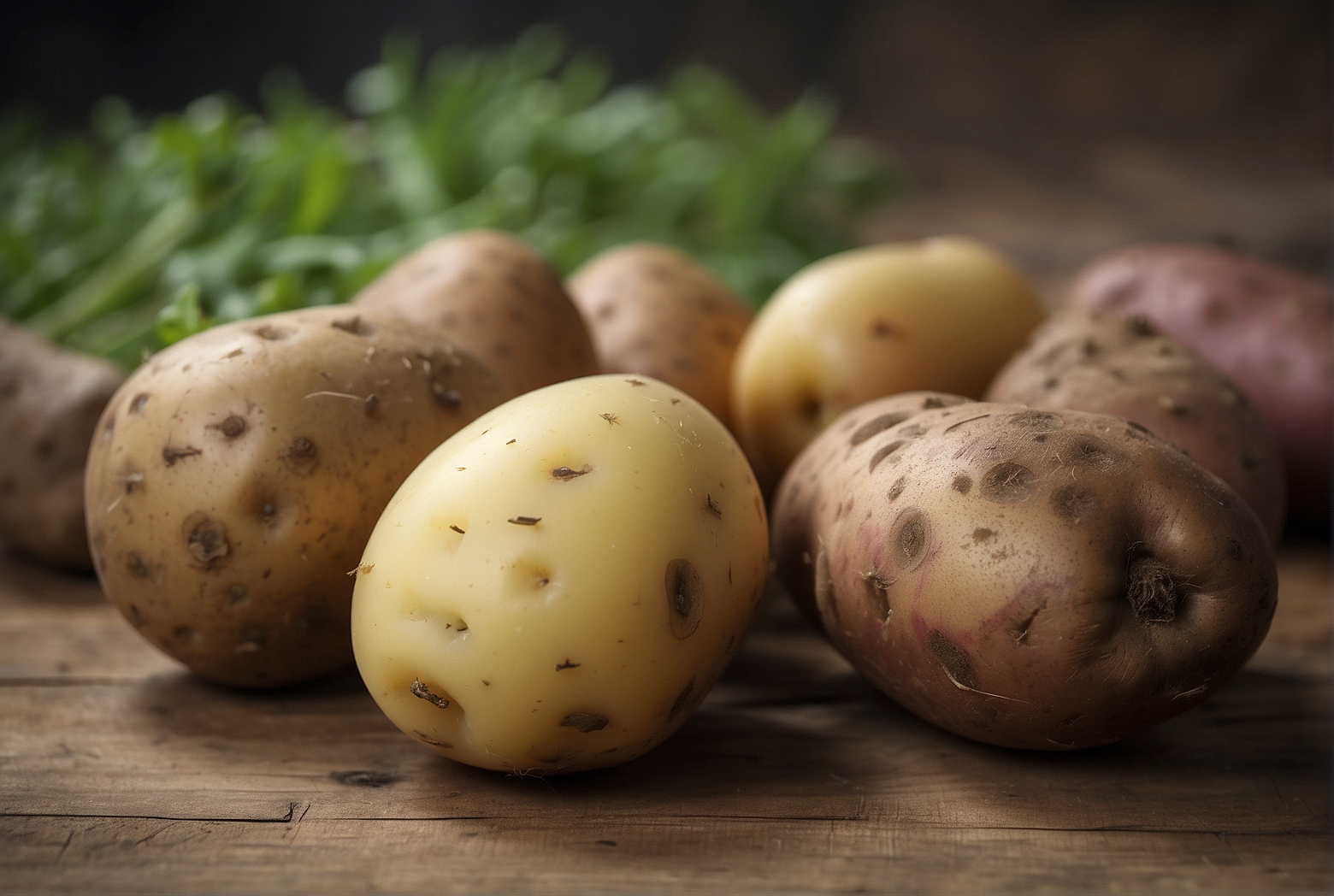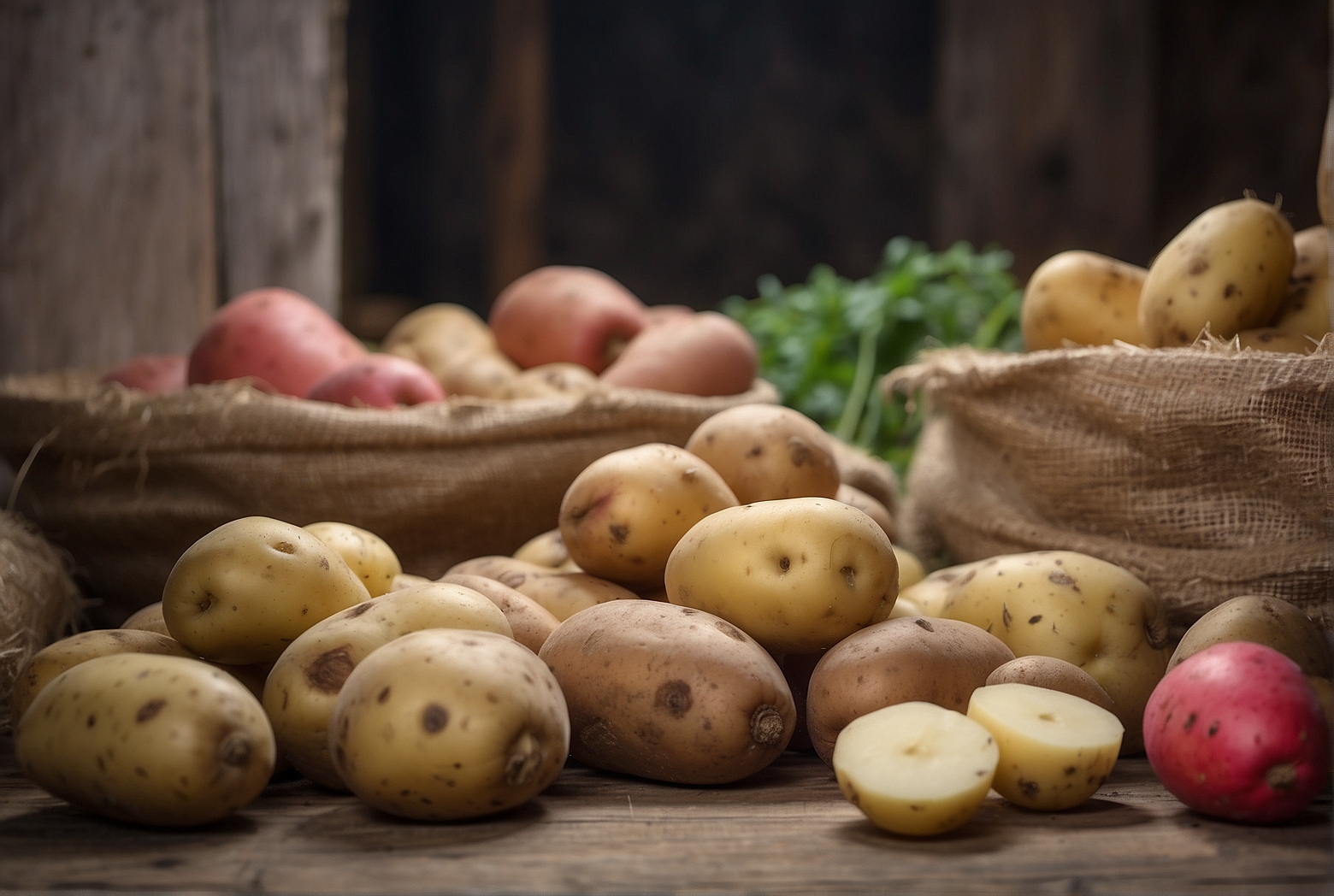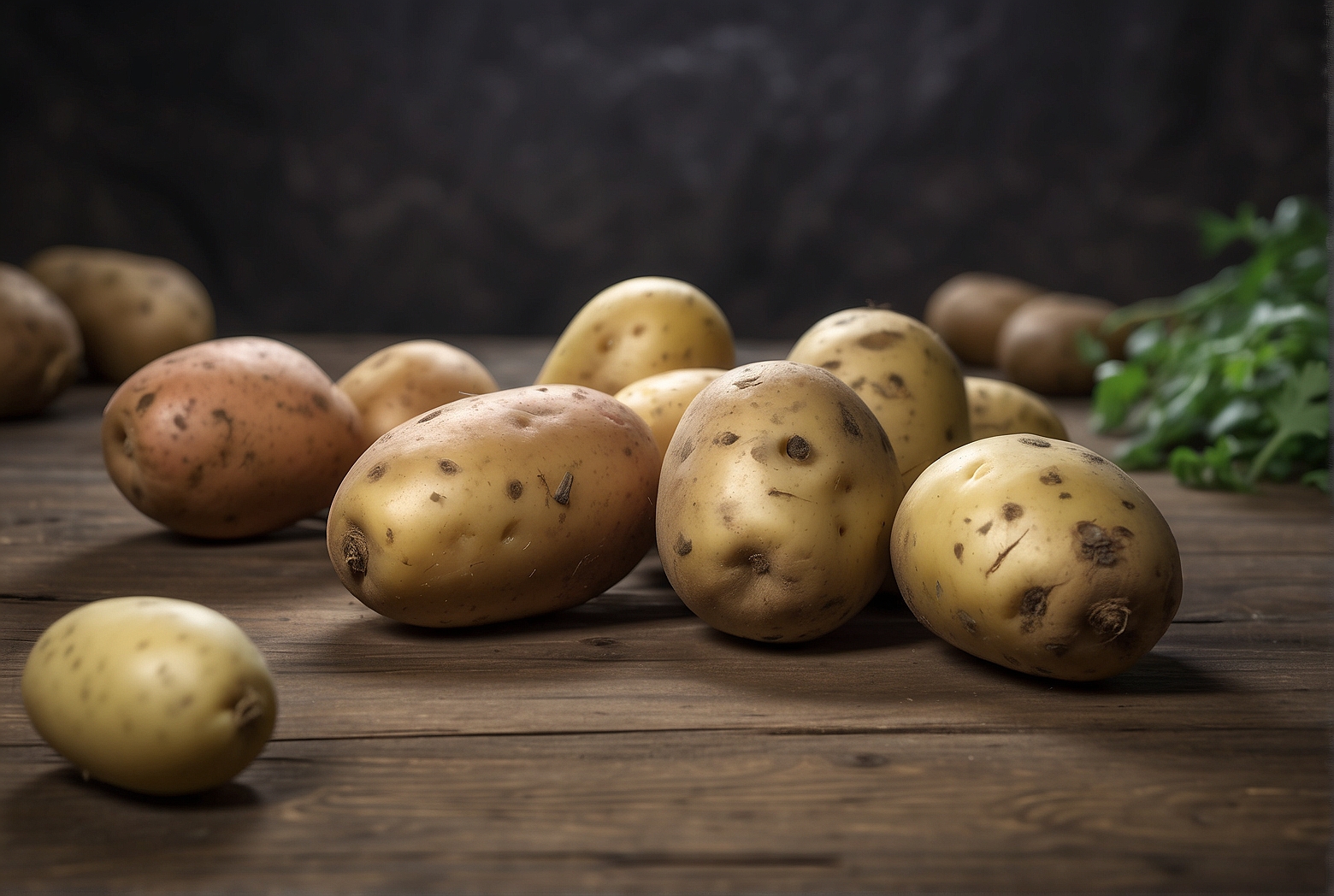Last Updated on April 1, 2024 by Tony Manhart
Have you ever wondered how to tell if the potatoes you have are determinate or indeterminate? Determinate potatoes are known for their compact growth and limited height, making them ideal for smaller garden spaces. On the other hand, indeterminate potatoes are characterized by their vining nature, growing taller and producing a larger yield. In this article, we will explore the various indicators that can help you distinguish between these two types of potatoes. By the end, you’ll have a clear understanding of which variety you have and how to make the most of your potato planting experience.
Size and Shape
When determining the characteristics of potato plants, it’s important to consider their size and shape. By observing these factors, you can gain valuable insights into the nature of the potatoes you are growing. Assessing the size of potato plants involves measuring their height, width, and overall volume. This can give you an idea of how much space they will occupy in your garden or container. Additionally, examining the shape of potato plants can reveal whether they have a more compact or sprawling growth habit, which can affect their overall yield potential.
Determining size characteristics
To determine the size characteristics of potato plants, start by measuring their height. This can be done by using a measuring tape or ruler to measure from the base of the plant to its highest point. Additionally, measure the width of the plant by measuring the distance between the widest points of the foliage. Finally, calculate the overall volume of the plant by multiplying its height, width, and depth. By considering these measurements, you can get a better understanding of the size of your potato plants and plan accordingly.
Identifying shape features
When it comes to identifying the shape features of potato plants, pay close attention to their growth habit. Some potato varieties have a more compact growth habit, meaning they tend to grow in a more upright and confined manner. These determinate varieties often have shorter stems with closely clustered leaves, giving them a more bushy appearance. On the other hand, indeterminate potato varieties have a sprawling growth habit, with longer stems and more widely spaced leaves. This allows them to spread out and cover more ground. By identifying the shape features of your potato plants, you can choose the appropriate growing methods and provide the necessary support, if needed.

Growth Habit
The growth habit of potato plants refers to their growth patterns and habits. By observing the growth habit of your potato plants, you can better understand how they will develop and produce tubers. Additionally, recognizing the differences between determinate and indeterminate growth habits can help you plan your planting and harvesting schedules more effectively.
Observing plant growth patterns
To observe the growth patterns of your potato plants, pay attention to the direction and rate of their growth. Potato plants typically begin as small sprouts emerging from the seed potatoes or seedlings planted in the ground. As they mature, you will notice new leaves and stems forming, indicating the plant’s growth. Take note of the direction of growth – determinate plants tend to have more upward growth, while indeterminate plants spread out horizontally. By observing these growth patterns, you can adjust your planting spacing and provide adequate support for your plants.
Differentiating determinate and indeterminate growth habits
Determinate and indeterminate growth habits have distinct characteristics that set them apart. Determinate potato plants have a defined growth cycle, meaning they will reach a certain height, produce a specific number of leaves, and then stop growing. This growth habit is advantageous for gardeners with limited space or those looking for a more compact plant. Indeterminate potato plants, on the other hand, continue to grow and produce new leaves and stems throughout the growing season. This allows them to potentially yield more tubers but requires more space and support. By differentiating between determinate and indeterminate growth habits, you can select the appropriate varieties for your gardening situation.
Foliage Appearance
The foliage appearance of potato plants can provide valuable information about their health and vigor. By examining the structure and density of the leaves, you can gain insights into the overall condition of your potato plants. Foliage appearance is an essential aspect to consider when assessing the growth and potential yield of your plants.

Examining leaf structure
When examining the foliage appearance, pay close attention to the structure of the leaves. Healthy potato plants typically have vibrant green leaves that are broad and elongated, resembling an open palm. These leaves should feel firm and have a smooth texture. Any discoloration, wilting, or signs of damage may indicate nutrient deficiencies, pests, or diseases. Examine the undersides of the leaves for signs of pests, such as aphids or Colorado potato beetles. By examining the leaf structure, you can detect any issues early on and take appropriate measures to maintain the health of your plants.
Noticing foliage density
The density of foliage refers to how closely leaves are spaced on the stems of potato plants. A denser foliage can indicate a more vigorous plant with the potential for higher yield. When inspecting the foliage density, look for a thick canopy of leaves that covers the stems without overcrowding or overshadowing nearby plants. However, if the foliage appears too sparse, it may indicate nutrient deficiencies or improper growing conditions. By noticing the foliage density, you can adjust your fertilization and watering practices to ensure the optimal growth of your potato plants.
Flower Development
Flower development in potato plants plays a critical role in the production of tubers. Understanding the process of flower initiation and the factors that contribute to flower production can help you maximize tuber set and ultimately enhance your harvest.
Analyzing flower initiation
Flower initiation is the process by which potato plants start developing flowers. This phase occurs after the plants have reached a certain stage of growth and environmental conditions are favorable. Flower buds typically form at the leaf axils, which are the junction points between the stems and the leaves. Analyzing flower initiation involves closely examining the base of the stems and the leaf axils for the emergence of small buds. The presence of these buds indicates that your potato plants are transitioning into the flowering stage, which is a promising sign for future tuber development.
Understanding flower production
Once the flower buds have initiated, potato plants will undergo the process of flower production. Flowers are essential for potato plants as they facilitate pollination, which is necessary for tuber formation. As the flowers open and become receptive, they attract pollinators such as bees and other insects. These pollinators transfer pollen from the male parts of the flowers to the female parts, allowing fertilization to occur. This process triggers tuber formation and development. Understanding the importance of flower production in potatoes can help you ensure proper pollination and maximize tuber set.
Tuber Set
Tuber set refers to the formation of tubers on potato plants. It is a critical stage in potato growth, as it determines the quantity and size of the tubers you will ultimately harvest. Recognizing the signs of tuber formation and understanding the differences between determinate and indeterminate tuber sets can help you better manage your potato crops.
Recognizing tuber formation
To recognize tuber formation, observe the lower portion of the potato plant, specifically the area where the roots and the underground stems meet. As the plants develop, you will notice small protrusions, known as tubers, forming along the stems. These tubers start off small and grow in size as the plants continue to develop. It’s important to note that not all tubers will necessarily develop to their full potential or be suitable for harvesting. By recognizing the signs of tuber formation, you can monitor the progress of your potato plants and anticipate a bountiful harvest.
Differentiating determinate and indeterminate tuber sets
Determinate and indeterminate tuber sets have distinct characteristics that differentiate them from each other. In determinate varieties, tuber set occurs at a specific stage of plant development, usually after flowering, and the majority of tubers grow in a concentrated area. This uniform tuber set is advantageous for harvesting ease and consistency in size. Indeterminate varieties, on the other hand, have an extended tuber set period, often continuing even after flowering. As a result, the tubers may be distributed more erratically along the underground stems. Differentiating between determinate and indeterminate tuber sets allows you to choose the appropriate varieties based on your harvesting preferences and growing conditions.
Harvest Time
Determining the optimal harvest time for your potatoes is crucial to ensure that you enjoy the best flavor and texture while avoiding premature or overripe tubers. By noting whether your potatoes exhibit early or late maturity characteristics and being aware of the factors that influence the harvest period, you can make informed decisions regarding when to harvest your crop.
Noting early or late maturity
Noting the maturity characteristics of your potato plants can provide valuable insight into the optimal harvest time. Some potato varieties exhibit early maturity, meaning that their tubers reach a harvestable stage relatively quickly compared to other varieties. Early-maturing potatoes tend to have thinner skins and a more delicate flavor. On the other hand, late-maturing potatoes take a longer time to reach their peak harvest stage. These varieties often have thicker skins and a more robust flavor. By noting whether your potatoes demonstrate early or late maturity, you can plan your planting and harvesting schedule accordingly to ensure that you harvest your tubers at their prime.
Determining optimal harvest period
The optimal harvest period for potatoes is influenced by various factors, including the desired texture, flavor, and storage capabilities. Typically, potatoes are harvested when their skins are well-set and can withstand light pressure from a finger or thumb without breaking or cracking. The tubers should also have reached their desired size, depending on your culinary preferences. Additionally, it’s important to consider the weather conditions during the harvest period, as excessive moisture or frost can negatively impact the quality and storage life of the harvested potatoes. Determining the optimal harvest period requires a balance of these factors, ensuring that you harvest your potatoes at the peak of their flavor and quality.
Yield Potential
The yield potential of potato plants refers to the amount of tubers they can produce under favorable growing conditions. Assessing the yield potential of your potato varieties can help you estimate the quantity of tubers you can expect and plan your planting accordingly. Understanding the differences between determinate and indeterminate yield potential is crucial for selecting the appropriate varieties for your desired yield.
Assessing productivity level
When assessing the yield potential, consider the productivity level of your potato varieties. Higher-yielding varieties tend to produce a larger quantity of tubers per plant, resulting in an increased harvest. Productivity level can be influenced by various factors, including the genetics of the variety, the growing conditions, and the management practices employed. It’s important to note that yield potential is not solely determined by the number of tubers but also by their size and overall quality. By assessing the productivity level of your potato varieties, you can have a better understanding of the potential harvest and make any necessary adjustments to optimize yield.
Identifying determinate and indeterminate yield potential
Determinate and indeterminate yield potential can vary significantly. Determinate potato varieties typically have a more predictable and consistent yield since they have a defined growth cycle and a concentrated tuber set. The yield of these varieties can be estimated more accurately, allowing for better planning and allocation of resources. On the other hand, indeterminate potato varieties, with their prolonged tuber set and more distributed tubers, can have a higher overall yield potential. However, achieving optimal yield with indeterminate varieties requires careful management and monitoring. Identifying the determinate and indeterminate yield potential of your potato varieties will help you choose the most suitable ones for your specific growing conditions and harvesting goals.
Variety Classification
Potato varieties are classified into different types based on their characteristics and uses. Researching the various potato variety types can help you select the ones that best suit your preferences and specific culinary needs. Matching the variety descriptions with your desired outcomes ensures that you grow potatoes that meet your expectations.
Researching potato variety types
When researching potato variety types, consider the primary uses of each variety. Some varieties are specifically bred for boiling, baking, frying, or mashing. Others are classified as all-purpose, with characteristics that make them suitable for various cooking methods. Additionally, consider the specific traits and qualities of each variety, such as their flesh color, texture, and flavor profile. By researching different potato variety types, you can expand your potato-growing repertoire and discover new flavors and culinary possibilities.
Matching variety descriptions
Matching the variety descriptions with your specific needs and preferences is essential when selecting the right potato varieties. Take into account factors such as the desired texture, color, and flavor of the tubers, as well as their adaptability to your local climate and growing conditions. Consider whether you prefer waxy or floury potatoes, and whether you require varieties that store well over extended periods. By matching the variety descriptions to your requirements, you can ensure that you grow the potatoes that will meet your culinary expectations and preferences.
Genetic Information
Understanding the genetic characteristics of potato plants can provide valuable insights into their growth habits and traits. By studying the genetic makeup of determinate and indeterminate potato varieties, you can better comprehend the factors influencing their growth, yield potential, and overall performance.
Studying genetic characteristics
Studying the genetic characteristics of potato plants involves exploring their genetic makeup and the traits associated with determinate and indeterminate growth habits. Numerous genes influence the growth and development of potato plants, including those responsible for determining stem length, leaf structure, and tuber formation. By studying these genetic characteristics, scientists and breeders can identify the genes that contribute to specific traits and use that knowledge to develop improved varieties. Studying genetic characteristics can provide valuable insights into the underlying mechanisms that govern potato growth and yield potential.
Understanding determinate and indeterminate genetic traits
Determinate and indeterminate growth habits in potato plants are governed by specific genetic traits. Determinate varieties possess genes that regulate the termination of stem growth, resulting in a more compact plant and a concentrated tuber set. These genes also contribute to the limited growth cycle of determinate plants. In contrast, indeterminate varieties carry genes that allow continuous stem growth and tuber formation. By understanding the determinate and indeterminate genetic traits, scientists and breeders can manipulate these genes to create potato varieties with desired growth patterns and yield potentials.
Expert Consultation
Seeking guidance from professionals can provide valuable assistance and insights when it comes to growing potatoes. Consulting horticulturists or agricultural experts can help you with specific inquiries and challenges you may encounter throughout the cultivation process.
Seeking guidance from professionals
If you have specific concerns or questions about growing potatoes, seeking guidance from professionals is a wise approach. Horticulturists and agricultural experts have extensive knowledge and experience in potato cultivation and can provide solutions tailored to your unique situation. Whether you need advice on pest management, soil fertility, or optimal growing techniques, reaching out to professionals can help you resolve any challenges and ensure a successful potato crop.
Consulting horticulturists or agricultural experts
When consulting horticulturists or agricultural experts, it’s important to come prepared with specific questions or concerns. Provide them with relevant information about your growing conditions, such as the climate, soil type, and available resources. This will allow the experts to provide you with more accurate and relevant advice. Take note of their recommendations and implement them accordingly. Consulting horticulturists or agricultural experts can be a valuable resource throughout your potato-growing journey, helping you optimize your practices and achieve the best possible results.
Tony Manhart is a passionate gardener who has been tending to gardens for over 20 years. He takes pride in creating beautiful outdoor spaces with plants, trees, and shrubs that can thrive in any environment. He loves to share his knowledge with others and has taught classes on gardening basics and advanced techniques. He is committed to sustainability, using natural and organic methods to create and maintain gardens. He also works with local organizations to create green spaces for communities. When he’s not gardening, Tony enjoys hiking, reading, and spending time with his family.


